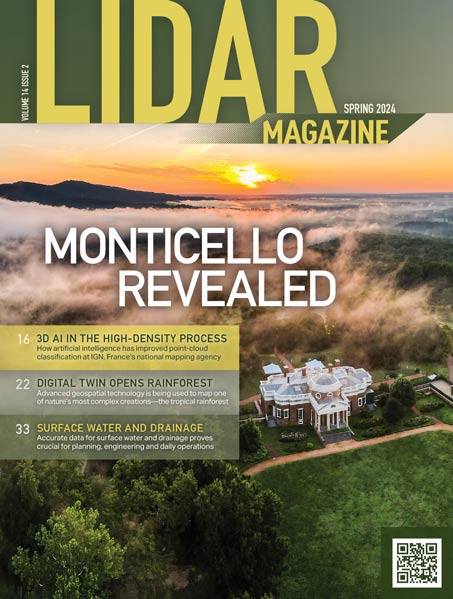A new last minute addition to the International LiDAR Mapping Forum conference program will include two presentations on how LiDAR is being used in Haiti to assess the damage from the recent earthquake and the future probability of subsequent earthquakes.
Imagery of the region damaged by the M 7 Haiti earthquake, including high-resolution photography and airborne LiDAR, has revealed a variety of ground failure that resulted from shaking. Surprisingly, the Enriquillo Fault seems to have not ruptured at the ground surface, so the negative result obtained from imagery has significant implications. The USGS issued a statement, based on imagery analysis, that because it is clear that the rupture of the Enriquillo Fault was clearly farther west than Port-au-Prince, and because rupture was buried deep on the fault, there is a significant risk of not only regular aftershocks, but also the threat of a subsequent large event that could occur even closer to Port-au-Prince.
The probability of one or more subsequent earthquakes of M 7 or greater increased by about 3% for the 30 days following 21 January 2010. Although this is a low probability, it would be a potentially very high impact event. High-resolution imagery was crucial to this assessment.
Kenneth W. Hudnut, Ph.D, Geophysicist at the U. S. Department of the Interior – U. S. Geological Survey will present The M 7.0 Haiti Earthquake of 12 January 2010: How LiDAR Helps at the upcoming International LiDAR Mapping Forum. The Paper will focus, not only on the future probability of aftershocks, but also on how LiDAR data is being used to assess the distribution of earthquake-induced landslides in Haiti and in the general relief effort by assisting agencies with assessing the damage to buildings, roads, bridges and port facilities.
Building on the overview presented in Dr Ken Hudnut’s paper, John Antalovitch, President and Andrew Mitchell, LiDAR Processing Specialist of Kucera International in Willoughby,OH, are then giving a paper on their LiDAR missions in January this year covering the Haiti earthquake fault area and Port Au Prince and Leogane.
Kucera International Inc. in collaboration with the Rochester Institute of Technology (RIT) and ImageCat of Long Beach, California was sponsered by the World Bank to perform a high resolution aerial lidar and multispectral image survey of primary earthquake damaged areas and fault zones. The surveys were performed from Kucera’s dual-sensor port twin-engine aircraft using Kucera’s Leica ALS60 aerial lidar system and RIT’s WASP multispectral sensor. The aerial flyover was conducted from January 21 through January 27 and covered Port-au Prince, Leogane, Petit Goave, Grand Goave, Fermante, Jacmel, and the western and central Enriquillo fault line. The team members worked round-the-clock to process and distribute the aerial data immediately following acquisition to the World Bank and other assisting organizations. The data is currently being used for the ongoing relief and rebuilding effort.
Kucera’s presentation will review the performance of the aerial survey, the expedited processing and distribution of the aerial data, and potential future refinement and applications of the data.
Full details on ILMF10 including the conference program can be found at www.lidarmap.org or you can contact info@lidarmap.org
About the International LiDAR Mapping Forum (ILMF)
The ILMF is the established premier event for the LiDAR industry, attracting professionals from all over the world. This 10th annual summit is the focal gathering of industry, leaders, pioneers, experts from government, academia and professionals from industries looking to invest in and benefit from LiDAR technology and services.
About the Speakers
Kenneth W. Hudnut, Geophysicist for the U.S. Geological Survey Kenneth W. Hudnut studies earthquakes as a geophysicist for the U. S. Geological Survey in Pasadena, California. He is the Coordinator for the Southern California Region on the U. S. Earthquake Hazards Program Council and serves on the Board of Directors for the Southern California Earthquake Center. He led the earthquake source design and computer simulations of the ShakeOut scenario, a magnitude 7.8 earthquake on the San Andreas fault. Since receiving his Ph.D. from Columbia in 1989, and his A.B. (high honors) from Dartmouth in 1983, he has published over 80 scientific papers. He is a Visiting Associate in Geophysics on the faculty of the California Institute of Technology.
John Antalovich Jr., President of Kucera International Inc John Antalovich Jr., PE, PS – President of Kucera International Inc. has been working in the field of aerial sensing/surveying and photogrammetryfor over 30 years. Mr. Antalovich has a BS in Civil and Environmental Engineering from Cornell University and an MBA in Information Systems Technology from Case Western Reserve University. Mr. Antalovich is active in the ASPRS, MAPPS, and other professional photogrammetry/surveying/mapping organizations.
Andrew Mitchell, LiDAR Processing Specialist, Kucera International Inc Andrew Mitchell – Kucera LiDAR Processing Specialist has been working in the area of aerial LiDAR processing and applications since 2003. Mr.
Mitchell has a BS in Regional Planning from Westfield, MA State College with a minor in Computer Science and certificate in Geographic Information Systems. Before joining Kucera in 2005 he worked as a LiDAR data GIS
Specialist for Optram Inc. of Hadley, MA.
